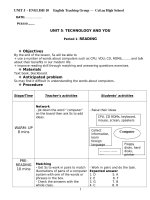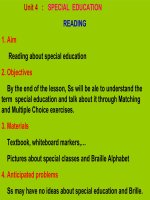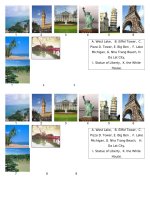unit 4-E 10
Bạn đang xem bản rút gọn của tài liệu. Xem và tải ngay bản đầy đủ của tài liệu tại đây (1.12 MB, 24 trang )
Warm- up: Miming.
One student goes to the black board, do not
say anything only using sign language to
express what she/ he means. The others try
to guess what he/ she means
1. Eat 6. Read book
2. Brush teeth 7. Swim
3. Walk 8. Play football
4. Sleep 9. Hungry
5. Listen to music 10. Hot
1.Who often uses sign
language or gestures to
express what they
mean?
2 Look at the pictures
and tell me who are
they?
Disabled people
Blind people
Deaf and mute people
Schools for disabled
children are called special
schools. Name some
special school you know
Nguyen Dinh Chieu
special school for the
blind
These dots represent the alphabet of a
These dots represent the alphabet of a
language for the blind. What is the name of the
language for the blind. What is the name of the
language
language
•
The Braille Alphabet
Work in pairs, look at the
Braille Alphabet, work out
the message that follows
I Before you read
The message: We are the world
Sign language with fingers to communicate
•
II. While you read: Read the passage in silent in
5 minutes and do the task that follow
Task 1: The words in A appear in the reading
passage. Match them with their definitions in B.
A B
1. Disabled
2. Mentally retarded
3. Time-consuming
4. Demonstration
5. Gradually
a. Taking or needing a lot of time
b. An act of showing or explaining
how to do something.
c. Unable to use a part of the body in
the normal way.
d. Slowly, over a long period of time.
e. Less mentally developed than
normal
Task 1: The words in A appear in the reading
passage. Match them with their definitions in B.
A B
1. Disabled
2. Mentally retarded
3. Time-consuming
4. Demonstration
5. Gradually
c. Unable to use a part of the body in the
normal way.
e. Less mentally developed than normal
•
Taking or needing a lot of time.
• An act of showing or explaining
how to do something.
•
d. Slowly , over a long period of
time
Task 2: Read the passage again and complete the following
sentences by choosing the best letter A, b, C or D.
1. Thuy’s class is different from other classes because the children…
A. Are from large families. B are less mentally developed.
C.Love Maths very much D.are disabled.
2. At first the parents were…the ideas of sending their children to the
special class.
A. Interested in B. opposed to C. Satisfied with
D. worried about.
3. The writer’s attitude towards Thuy’s work in the passage can be
described as……
A. Humorous B. angry
C. Suspicious D. admiring
Task 2: Multiple choice.
4. It can be inferred from the 2nd paragraph of the reading passage
that there has been….
A. a change in the parents’ attitude towards the class.
B. a lot of protest from the parents against the class.
C. a feeling of doubt in the teacher’s ability
D. a belief in the parents’ opposition.
5. The writer describes how Thuy teaches the children to add and
subtract in order to prove that…
A The children like Maths.
B The teacher is a proud of her work.
C. The teaching work takes time.
D. Adding and subtracting are important
Task 3: Gap filling.
Twenty-five ……………children have the chance of
learning how to …………and………thanks to
the………… of a young teacher, Pham Thu Thuy.
Although her idea, at first, met with………….…from
the parents of the disabled children, more children
attended her class later. The teaching work in the
special class is………. ………… For example, in
a……… lesson, the teacher has to use
her………… and ………… to teach the children how
to add and subtract. The children are now ……… and
happy.
disabled
read write
efforts
opposition
time-consuming
Maths
arms
fingers
proud
C After you read:
1.Name some famous disabled people you
know
2.Discuss the problems of the deaf and the
mute and other disabled people in their
daily life and how they overcome them
an American lecturer and writer
An American President.
Franklin Deland Roosevelt
with disability
Morla Rungan
-wearing number
3375, the 1
st
blind
USA Olympic athlete
in 2000 in Sydney
A dog can help the blind passing the road
Hearing aids for the deaf
A Wheel chair for the disabled
Walking stick for the Blind
Home work: Do
exercises in work
book , reading part
and prepare for the
speaking period









